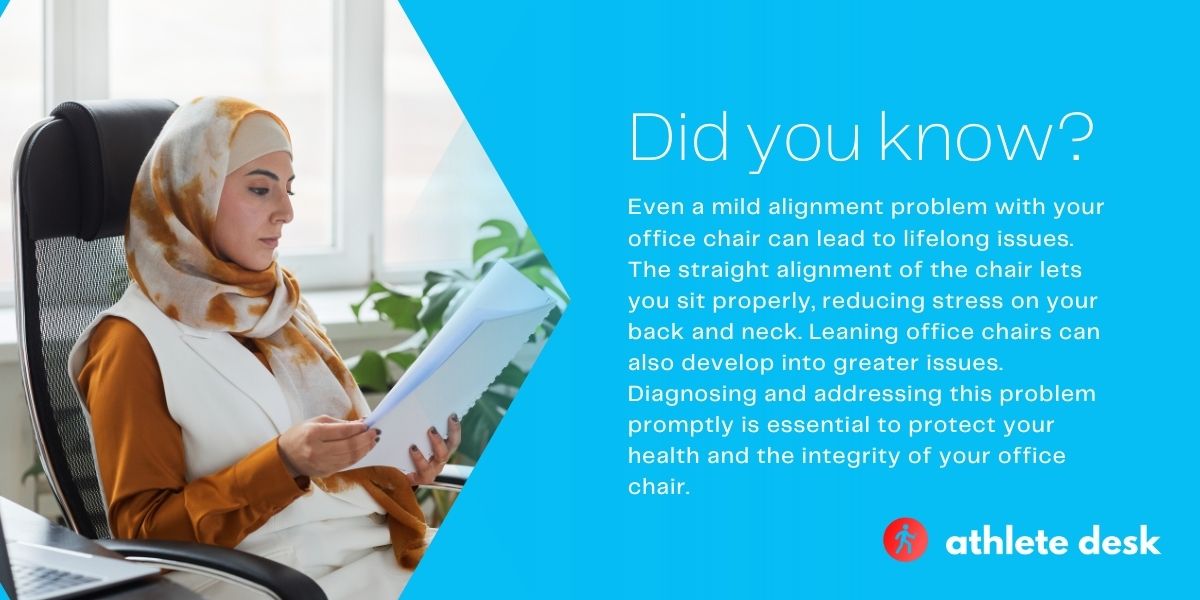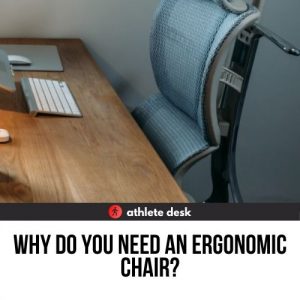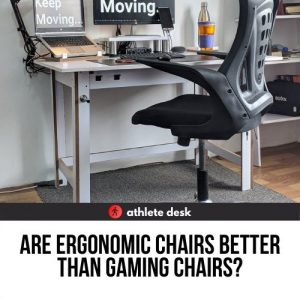The common reasons office chairs lead to one side include:
- Missing bolts or screws
- Damaged casters
- Damaged swivel seat plates
Apart from these issues, the office chair may have greater damage that merits complete replacement.
In this article, we explain how to diagnose and fix an office chair that leans to one side and when you should consult an expert for repairs.

The Problem With Office Chair Leaning
Even a mild alignment problem with your office chair can lead to lifelong issues. The straight alignment of the chair lets you sit properly, reducing stress on your back and neck.
Leaning office chairs can also develop into greater issues. A broken wheel can eventually break the base of the chair, which becomes a more costly repair.
Diagnosing and addressing this problem promptly is essential to protect your health and the integrity of your office chair.
Read More >> How to Prevent Static Shock from an Office Chair?
Diagnosing an Office Chair that Leans to One Side
Before you can go out and buy replacement parts, you need to find the root of the problem.
Sit or apply downward pressure to the chair to determine which way the chair is tilting or leaning. This can also give you a better feel of where the problem is occurring.
Read More >> Should Office Chairs Tilt Forward?
For example, an issue in the swivel seat plate will feel looser than a caster issue as the casters are closer to the ground.
They will stabilize easier with enough pressure from both sides, but the seat plate doesn’t have the same opportunity.
Turn the office chair upside down, setting the top of the seat on a stable surface, having someone hold the chair for you. This lets you easily inspect the lower part of the chair where the issue originates.
Check the legs for any breaks or bends. If the chair uses a weaker plastic material, make sure there are no seams where the chair might crease when you sit.
You should also make sure each caster has all the screws needed to hold it in place.
Hydraulic chairs have a plate under the seat that contains most (sometimes all) of the chair’s accessories.
This also supports the weight of the office chair and anyone sitting on it.
Damage to the seat place can cause the chair to lean to one side, and it might interfere with other functions, like adjusting the height or tilt of the chair.
There’s also the possibility that you cannot easily determine the source of your office chair’s lean.
We find that these are the most common issues, but the failure of internal components can occur.
The likeliness of this increases with more complicated chair designs and functions.

Fixing an Office Chair that Leans to One Side
Once you discern the root of the issue, move on to fixing the office chair’s improper leaning. The aforementioned issues, this include:
- Replacing missing bolts or screws
- Replacing (or upgrading) casters
- Replacing broken chair legs
- Replacing the seat plate
These quick and easy fixes should solve your problem.
If you are missing screws alongside another issue, make sure you replace them with the other component to prevent the issue from recurring.
Replacing Missing Bolts or Screws:
Replacing the missing bolts and screws is not difficult, but finding replacements can be.
Luckily, most chairs use similar sizes of fasteners for most of their parts, and you should be able to grab one from another area.
Some chairs include additional parts that you can take advantage of, or they may list the fastener dimensions in the “included hardware” section. You can also try contacting the manufacturer for these details, and they may send you a replacement for free.
The most straightforward approach is taking the bolt or screws with you to the hardware store and visually assessing the size.
This works in most cases, but it’s not ideal for ordering online. There is also the possibility that you view things incorrectly and end up with a fastener you cannot use.
Many have sizing plates for you to test bolts on. You might need to ask an associate, but this can help you avoid taking measurements and find the perfect size.
Alternatively, you can print out a size chart at home, but you need to make sure you print the document without fitting it to the page or down-scaling.
If you cannot find a proper replacement, see if there’s another bolt or screw on the chair that you can relocate without destabilizing the chair further.
We recommend against this because it’s likely to lead to more issues, but it should work in a pinch.
Read More >> How to Fix a Squeaky Chair?
Replacing and/or Upgrading Casters:
If you have broken, bent, or collapsed casters, you need to replace that wheel.
This is usually as simple as removing the screws and pulling the caster off, but it’s not as easy to find a single caster for the replacement.
These most often come as sets, so this is the perfect opportunity to upgrade your wheels to something sturdier that will not break or bend as easily. You can purchase these as an exact replacement or a universal set that secures the legs in the same way.
Replacing Broken Chair Legs:
If you notice one of the office chair legs is broken, causing the chair to lean, you need to replace the chair base.
Start by removing the holding clip of the office chair using a pair of pliers, then pull the base from the chair.
You shouldn’t need tools to accomplish this, but you need to turn the chair counterclockwise. There may be grease from the gas cylinder.
Reverse this process to put the new base back on. Remember to put the holding clip back in place to secure the base completely.
Replacing the Seat Plate:
If the casters and legs are intact, then the seat plate is likely to blame. This usually happens as bolts back out, but the seat plate can bend and cause leaning.
Find a proper replacement and then remove the gas cylinder from the seat plate. This should pull out without unbolting, but you may need to use a rubber mallet to knock it loose.
Remove the seat plate by unbolting it from the base of the seat, then secure the plate to the office chair.
This should solve any issues you have with your office chair leaning to one side. If the problem persists, find a furniture repair technician who can better diagnose and address the issue.








